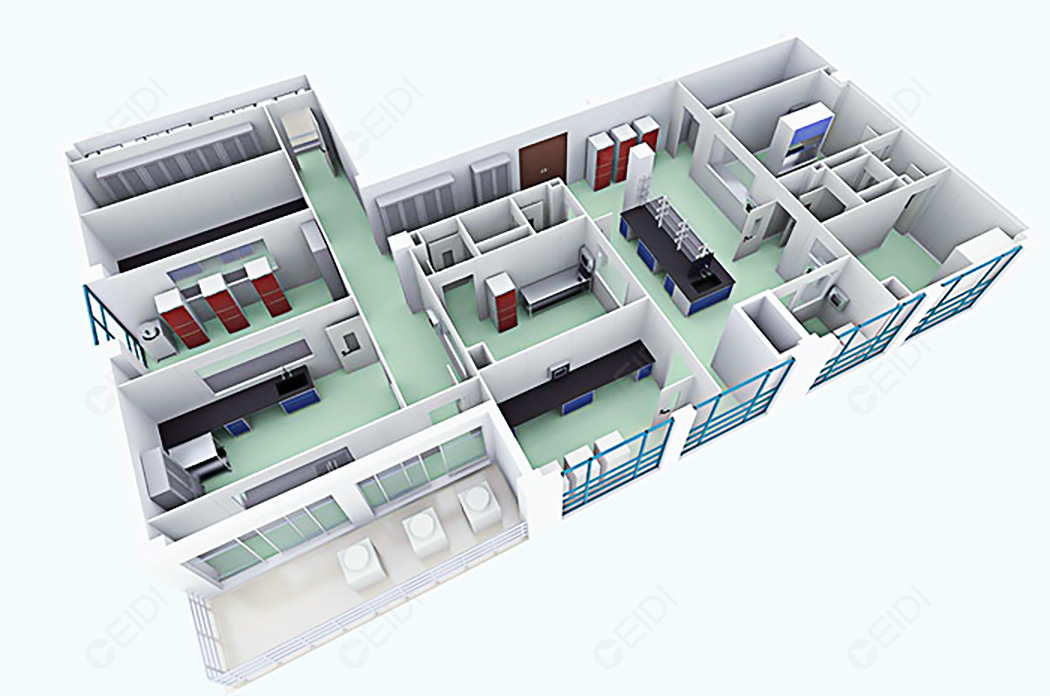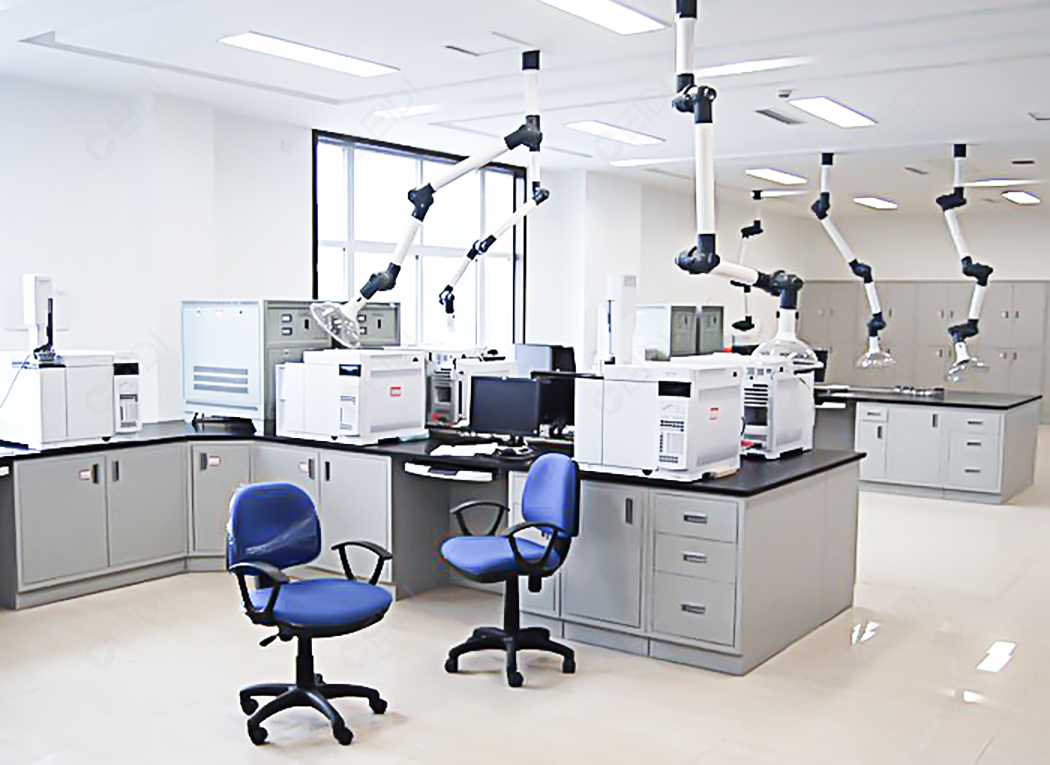Welcome to the official website of Xidi laboratory, the laboratory design and decoration recognize Xidi!
|
|
Home >> News >> Technology
文章出处:Technology|阅读量:817|发表时间:2021-02-25
Microbiology laboratory refers to a place where microbiological research is conducted. According to the safety requirements and use requirements of the microbiological laboratory, it is different from the general laboratory engineering or purification engineering. It is mainly used in the research fields of microbiology, biomedicine, biochemistry, animal experiments, genetic recombination, and biological products. Many of these content will involve cell culture research, so in this article, CEIDI is the biological cell culture laboratory This type is used for related science. Microbiology laboratory generally consists of five parts: preparation room, ordinary laboratory, sterilization room, constant temperature culture room and sterile room. The textures of their floors and walls need to be smooth and hard, and at the same time to ensure that the instruments and equipment are clean and tidy. The purpose is to make cleaning easier and better achieve cleanliness standards.

One. Preparation room
The preparation room is mainly used to prepare culture medium and sample processing. The preparation room must not only wash the utensils, but also need to be equipped with a laboratory bench, special counters, refrigerators, electric stoves and power supplies, water and sewage, etc. for storing utensils, reagent cabinets or materials. At the same time, the room should also be equipped with heaters, steamers, basins and barrels for washing utensils, as well as various decontamination powder, bottle brushes, washing powder, soap, etc.
Two, general laboratory
Ordinary laboratories are mainly used for the observation, counting and physiological and biochemical determination of microorganisms. The furnishings in ordinary laboratories vary greatly due to different work priorities. Generally, a microscope, experiment table, cabinet and stool are required. The laboratory cabinet should be large enough to accommodate daily utensils and medicines, and it also needs to be flat and smooth.
Three. Constant temperature culture room
1. Training indoor equipment and appliances
① The outer room should have special work clothes, shoes, caps, masks, hand-held sprayers, 5% carbolic acid solution, 70% alcohol cotton balls, etc.
②The inner room is usually equipped with a culture rack and a flask shaker (shaker). Commonly used bottle shakers are rotary and reciprocating.
2 Sterilization and disinfection of the culture room
①Same as sterilization and disinfection measures of sterile room.
② Small-scale cultivation can be carried out in a constant temperature incubator instead of a constant temperature incubator.
3. Setting up the cultivation room
①In both internal and external rooms, an ultraviolet lamp should be installed in the center of the room for sterilization.
②To meet the needs of microorganisms for temperature, a constant temperature and humidity machine must be installed.
③The upper part of the wall separating the inner room and the outer room should be provided with a vent with an air filter.
④ The culture room should have an inner and an outer room. The inner room is the culture room and the outer room is the buffer room. The volume of the room should not be large to facilitate air sterilization. The area of the inner room is about 3.2×4.4=14m2, the area of the outer room is about 3.2×1.8=6m2, and the height is about 2.5m. All ceilings should be provided.
Four, sterilization room
The sterilization room is mainly used for the sterilization of the culture medium and the sterilization of various appliances. The sterilization room should be equipped with sterilization equipment and facilities such as high-pressure steam sterilizers and ovens.
Five, sterile room
The sterile room can also be called the inoculation room, which is mainly used for the special laboratory for aseptic operations such as systematic inoculation and purification of bacteria. In microbiological work, the inoculation and transplantation of bacterial species is a major operation, and the characteristic of this operation is to ensure pure bacterial species and prevent contamination by other bacteria. In the air of the general environment, due to the presence of many dust and bacteria, it is easy to cause pollution and greatly interfere with the inoculation work.
1 Clean room working rules
① Sterilize in sterile room. Turn on the ultraviolet light for more than 30 minutes before each use, or spray 5% carbolic acid in the inner and outer chambers 30 minutes before use.
②After washing your hands with soap, move the necessary equipment into the outer room; put on sterilized work clothes, work caps and work shoes in the outer room, wear a mask, and then soak your hands with 2% cresol soap for 2 minutes.
③Move various needed items into the inner room for counting and put them in place, spray 5% carbolic acid on the work surface and the operator's station space, return to the outer room, and then enter the inner room for work after 5-10 minutes.
④Before the inoculation operation, wipe your hands with 70% alcohol cotton balls; when performing aseptic operations, the movements should be gentle to minimize air fluctuations and ground dust.
⑤ Pay attention to safety during work. If the cotton plug catches fire, hold it tightly with your hands or wrap it with a damp cloth. Do not blow it with your mouth to avoid expanding the burning; if the bacteria culture is spilled or the container with bacteria is broken, it should be wrapped with a cloth soaked in 5% carbolic acid , And wipe the countertop or floor with a cloth soaked in 5% carbolic acid, and then continue the operation after wiping your hands with an alcohol cotton ball.
⑥ At the end of the work, clean up the countertop immediately, take out all the items and wastes that should not be stored in the sterile room, spray 5% carbolic acid in the sterile room, or irradiate the sterile room for 30 minutes.
2. Clean room setup
The sterile room should be set up according to the principles of economy and science. The basic requirements are as follows:
① The volume of the sterile room is small and tight. After a period of use, the temperature in the room is very high, so ventilation windows should be provided. The ventilation window should be set on the ceiling of the entrance door of the inner room (that is, the position farthest from the workbench), preferably a double-layer structure, the outer layer is shutters, and the inner layer can be a sash window. The ventilation window can be opened after use in the inner room and before sterilization to circulate air. Constant temperature and humidity machine can be installed if possible.
②The sterile room should have an inner and an outer room, the inner room is a sterile room, and the outer room is a buffer room. The volume of the room should not be too large to facilitate air sterilization. The minimum inner room area is 2×2.5=5m2, and the outer room area is 1×2=2m2. The height should be less than 2.5m, and there should be a ceiling.
③A small window should be opened on the wall or "partition fan" that separates the inner and outer rooms to serve as a channel for passing items inside and out during the inoculation process, so as to reduce the number of people entering and leaving the inner room and reduce pollution. The small window is 60cm wide, 40cm high, and 30cm thick. Both inside and outside are hung with sashes.
④ A sliding door should be set in the inner room to reduce air fluctuations. The door should be located at the farthest position from the workbench; the door in the outer room should also be a sliding door, which should be located at the farthest position from the inner room.
3. Sterilization of sterile rooms
①Spray: before each use of the sterile room. The spray can promote the sedimentation of particles and microorganisms in the air, prevent the flying field of fine dust on the desktop and the ground, and has a sterilization effect. It can be sprayed with 5% carbolic acid.
②Fumigation: This is a measure of thorough sterilization in the aseptic room. When the sterile room has been used for a long time and the pollution is serious, it should be fumigated and sterilized. It can be fumigated with formaldehyde, lactic acid or sulfur.
③Ultraviolet radiation: before each use of the sterile room. Ultraviolet rays have a better sterilization effect. Usually, the ultraviolet light should be turned on for 30 to 60 minutes.
4. Aseptic room equipment and utensils
①Install an ultraviolet lamp (mostly 30W) in the inner room and the outer room. The ultraviolet lamp in the inner room should be installed directly above the frequently working seat, 2m from the ground, and the ultraviolet lamp in the outer room can be installed in the center of the outer room.
②The workbench in the sterile room, no matter what material or purpose it is, requires a smooth surface and a level surface.
③The interior room should have an alcohol lamp, common vaccination tools, stainless steel knives, scissors, tweezers, 70% alcohol cotton balls, industrial alcohol, glass slides, special crayons, notebooks, pencils, label paper, glue, and waste baskets Wait.
④ The outer room should have special work clothes, shoes, hats, masks, porcelain basins and towels containing Lysol water, hand-held sprayers and 5% carbolic acid solution, etc.

In summary, the construction of the microbial cell culture laboratory must be designed and decorated in accordance with the relevant decoration specifications and the needs of different users, so as to achieve the best results. CEIDI Xidi designers have rich design experience. Most of them have worked in the 10th Electronic Design Institute and the 11th Electronic Design Institute. In the early stage of the project, they will fully grasp the decoration needs of the project party’s customers through a combination of network and field surveys. Based on the specific type of the project, the relevant project team is formed, the project drawings are designed, and the drawings are modified through face-to-face communication with the customers, and finally the results are satisfied with the customers, taking into account practicality and beauty, and efficiently realizing the use of space. In the formation of the decoration construction team, it is also to "adjust measures to project conditions", what type of engineering team matches with the relevant experience and qualifications. Friendly reminder: For projects such as microbial cell culture laboratories that are particularly specialized in airflow, air pressure, water quality and other system requirements, they must cooperate with a contractor with matching qualifications and experience to achieve good project results.